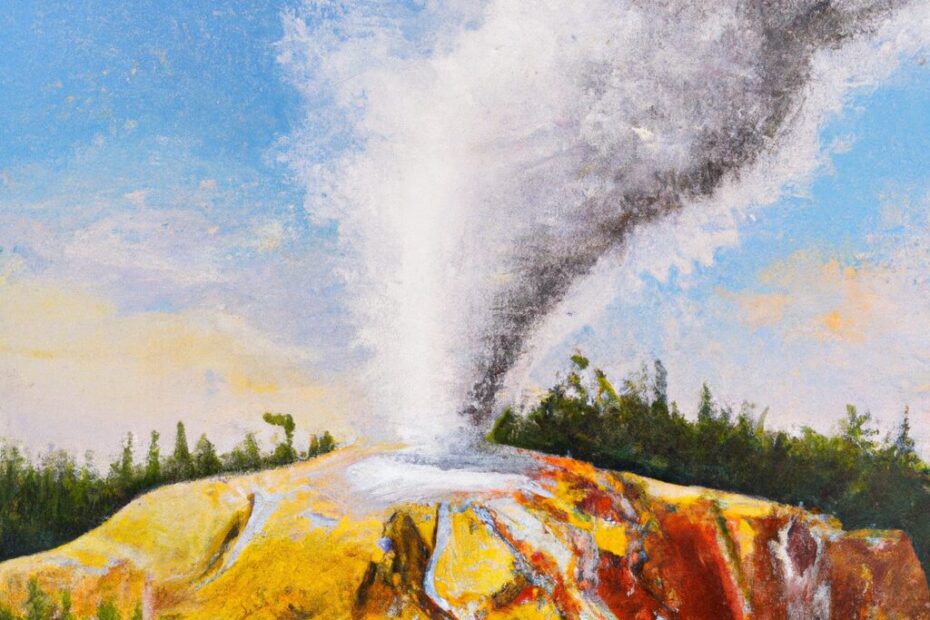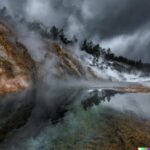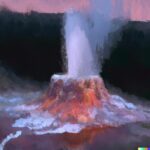Have you ever heard of the remarkable Steamboat Geyser? This natural wonder is located in Yellowstone National Park and is known for its sporadic and powerful eruptions.
But just how often does Steamboat Geyser erupt, and what factors influence its eruption frequency? In this article, we will explore the duration and height of these eruptions, as well as the signs that indicate an impending event. We will discuss the history of Steamboat Geyser eruptions and what the future holds for this fascinating natural phenomenon.
So, grab a cup of tea and let’s dive into the world of Steamboat Geyser!
What Is Steamboat Geyser?
Steamboat Geyser, located in Yellowstone National Park, is a remarkable geothermal feature known for its powerful and spectacular geyser eruptions.
Its eruptions can shoot water up to 300 feet into the air, making it the tallest active geyser in the world. One of the mesmerizing aspects of Steamboat Geyser is its unpredictable eruption patterns, with intervals between major eruptions varying from a few days to several years. This uniqueness adds to the allure of visiting Yellowstone National Park and experiencing the raw power of geothermal activity firsthand.
Where Is Steamboat Geyser Located?
Steamboat Geyser is situated in Wyoming, within the captivating landscape of Yellowstone National Park, which is renowned for its geological phenomena.
As the world’s tallest active geyser, Steamboat Geyser draws visitors from far and wide to witness its awe-inspiring eruptions that can reach heights of over 300 feet. Its location within the caldera of a supervolcano adds to the mystique, with geothermal features abounding in this unique region. The geothermal activity in Yellowstone National Park is a testament to the powerful forces brewing beneath the Earth’s surface, shaping the landscape and creating a truly spectacular natural wonder for all to marvel at.
How Often Does Steamboat Geyser Erupt?
The eruption frequency of Steamboat Geyser varies, showcasing irregular geyser eruption patterns that intrigue geologists and visitors alike.
Geologists have noted that unlike its neighboring geyser, Old Faithful, which erupts approximately every 60-90 minutes like clockwork, Steamboat Geyser operates in a more enigmatic manner. Its eruptions can occur months or even years apart, truly making it a marvel of nature’s unpredictability.
Some eruptions of Steamboat Geyser have been reported as the world’s tallest active geyser eruptions, reaching heights of over 300 feet, captivating onlookers with its awe-inspiring display of natural power.
What Are The Factors That Affect Eruption Frequency?
The eruption frequency of Steamboat Geyser is influenced by various factors such as geothermal monitoring, seismic activity, and geothermal activity forecasting, which play pivotal roles in understanding its eruption patterns.
Geothermal monitoring techniques involve the continuous observation of the geyser’s temperature, water levels, and gas emissions. This monitoring helps scientists track any anomalies that may indicate an upcoming eruption.
In addition, assessing seismic activity around the geyser provides valuable insights into the underground movements and potential build-up of pressure that could trigger an eruption.
Geothermal forecasting methods utilize data from monitoring and seismic activity assessments to predict the likelihood and timing of future geyser eruptions, aiding in public safety measures and research endeavors.
What Is The Duration Of A Steamboat Geyser Eruption?
The duration of a Steamboat Geyser eruption can vary, showcasing the dynamic nature of this geothermal phenomenon within the volcanic landscape.
These eruptions can range from several minutes to over 40 minutes in length, making each event a unique spectacle to witness. Such variations in eruption duration are often linked to the underlying volcanic activity that contributes to the geyser’s behavior.
Steamboat Geyser is known for its powerful eruptions, often reaching heights far greater than those of other geysers in the area. The surrounding geothermal features, such as colorful mineral deposits and bubbling hot springs, add to the dramatic display during the eruption process.
What Are The Signs Of An Upcoming Eruption?
Identifying the signs of an upcoming Steamboat Geyser eruption involves monitoring geothermal dynamics and observing geological formations for indicative changes.
- One of the key indicators of a potential eruption at Steamboat Geyser is increased seismic activity in the surrounding area.
- Geologists also pay close attention to any sudden fluctuations in temperature or pressure within the underground reservoirs, as these can suggest a build-up of magma and steam.
- Changes in the water levels of nearby hot springs and geysers can provide valuable insights into the overall hydrothermal system of the region.
By closely analyzing these various factors, experts can better predict and prepare for a possible eruption event at Steamboat Geyser.
Increase In Water Temperature
One of the key signs of an upcoming Steamboat Geyser eruption is the increase in water temperature, often accompanied by thermal anomalies detected through geothermal observations.
These rising water temperatures serve as a crucial indicator of the geyser’s heightened activity as they signify the building pressure beneath the Earth’s surface. Geothermal observation techniques, such as measuring ground temperature variations and monitoring gas emissions, play a vital role in tracking these thermal anomalies. By closely monitoring these geothermal indicators, scientists and researchers can better predict the timing and intensity of potential geyser eruptions, providing valuable insights into the underlying geological processes at work.
Changes In Water Levels
Observing changes in water levels is crucial for predicting Steamboat Geyser eruptions, as fluctuations in water discharge reflect underlying hydrogeological conditions.
By closely monitoring variations in the water level, researchers can gain valuable insights into the complex mechanisms that govern geyser activity. Understanding how water discharge rates correlate with geological factors such as fractures and fault lines provides key data points for predicting when Steamboat Geyser may erupt.
This monitoring process allows scientists to analyze trends over time, identifying patterns that indicate potential eruption events. The data collected from these observations plays a significant role in enhancing our understanding of the hydrothermal system beneath the geyser and improving our ability to forecast its behavior.
Changes In Geyser Behavior
Tracking changes in geyser behavior offers valuable insights into the potential of Steamboat Geyser eruptions, highlighting the intricate dynamics of its hydrothermal systems.
By closely monitoring variations in the duration, frequency, and intensity of eruptions, experts can gain a deeper understanding of the underlying processes that trigger such powerful geothermal events. The examination of water temperature fluctuations, venting patterns, and seismic activity in the geyser vicinity can serve as early warning indicators of potential volcanic activity. These meticulous observations provide scientists with crucial data to create predictive models for Steamboat Geyser eruptions, enhancing our ability to anticipate and prepare for these natural phenomena proactively.
What Is The Average Height Of A Steamboat Geyser Eruption?
The average height of a Steamboat Geyser eruption is remarkable, characterized by powerful steam emissions that showcase its location within a geothermal hotspot.
The eruptions of Steamboat Geyser can reach heights that capture the attention of visitors, with some towering even higher than a football field. The distinctiveness of the steam emissions from this geyser sets it apart from others in the area, creating a mesmerizing sight against the backdrop of the geothermal hotspot it belongs to. Being situated in such a geologically active region provides Steamboat Geyser with the intense heat and pressure needed to produce these awe-inspiring eruptions, demonstrating the raw power of nature’s forces at work.
How Long Does A Steamboat Geyser Eruption Last?
The duration of a Steamboat Geyser eruption can vary, from intense bursts of hot water to gradual releases, reflecting the complexity captured by geophysical data.
These temporal aspects provide valuable insights into the behavior of Steamboat Geyser, with some eruptions lasting for a few minutes while others continue for days. Geophysical data, such as seismic activity and ground deformation measurements, help scientists understand the underlying processes leading to these diverse eruption durations. Rapid hot water releases suggest a build-up of pressure in the geyser’s underground plumbing system, leading to sudden eruptions, while prolonged discharge events may indicate a slower release of accumulated heat and water. This variation showcases the dynamic nature of geothermal features and the importance of monitoring and analyzing such phenomena.
What Is The Best Time To See A Steamboat Geyser Eruption?
Determining the best time to witness a Steamboat Geyser eruption involves analyzing geothermal activity patterns and conducting in-depth geothermal phenomenon analyses.
Visitors planning a visit to the geothermal wonder of Steamboat Geyser should note that eruptions tend to occur in irregular intervals, with a typical frequency ranging from a few days to several weeks. By observing past eruption patterns and understanding the underlying geothermal processes, it is possible to potentially predict future eruptions. Being aware of environmental factors such as temperature fluctuations and seismic activity can provide further clues about the ideal timing to witness the awe-inspiring display of nature’s power.
What Are The Safety Precautions To Take While Visiting Steamboat Geyser?
Visitors to Steamboat Geyser should adhere to essential safety precautions recommended by geological surveys to ensure a secure and enjoyable experience.
One crucial safety measure is to stay on designated paths and viewing areas to avoid accidental falls or stepping on fragile geothermal formations. It is also important to obey all warning signs and barriers set up by park rangers for visitor safety. Visitors should stay a safe distance away from the geyser to prevent burns from the scalding hot water and steam that can erupt unexpectedly. Being mindful of these guidelines can help protect both visitors and the unique natural environment of Steamboat Geyser.
What Is The History Of Steamboat Geyser Eruptions?
The history of Steamboat Geyser eruptions is a fascinating narrative rooted in natural history, showcasing the evolution of this geological wonder over time.
From the earliest recorded eruptions in the late 1800s, the frequency and intensity of Steamboat Geyser’s activity have fluctuated significantly, capturing the attention of geologists and nature enthusiasts alike. Over the decades, researchers have observed patterns in the eruptions, with periods of heightened activity followed by extended periods of dormancy. This cyclical behavior has led to theories about the underlying geothermal processes that drive the geyser’s eruptions, shedding light on the complex interplay of water, heat, and steam deep beneath the Earth’s surface.
What Is The Future Of Steamboat Geyser Eruptions?
The future of Steamboat Geyser eruptions hinges on ongoing geothermal activity evaluation and meticulous geyser interval analysis to forecast its eruption patterns.
By closely monitoring the changes in underground pressure, temperature fluctuations, and seismic activity, researchers can gain insights into the behavior of Steamboat Geyser. This critical data allows experts to develop models that predict potential eruption timings and magnitudes.
Geyser interval analysis techniques, such as studying the duration between eruptions and the volume of water expelled, play a vital role in understanding the cyclical nature of geyser activity. These analyses contribute significantly to creating early warning systems for volcanic events, ensuring safety for nearby communities and preserving the natural geothermal wonders.
Last Updated on February 11, 2024 by Jon Waraas – Originally Posted: February 11, 2024

I’m Jon Waraas, and I’ve been navigating the online world since 2006. By day, I’m the proud owner of some eCommerce gems, and by night, I’m the voice behind the adventures on Waraas.Com.
My heart, however, belongs to the wild beauty of Yellowstone National Park. I’ve got a collection of websites dedicated to sharing the wonders of this natural masterpiece. Oh, and did I mention? I’m currently building my own cabin inside the ghost town of Gilmore, Idaho – a cabin with tales to tell!
When I’m not immersed in the digital realm, you’ll find me lacing up my boots for a good hike or setting up camp under the star-studded sky.




